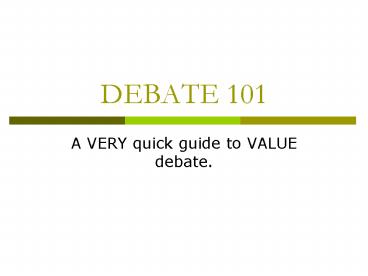DEBATE 101 - PowerPoint PPT Presentation
1 / 11
Title: DEBATE 101
1
DEBATE 101
- A VERY quick guide to VALUE debate.
2
a VALUE debate
- A value debate involves a moral argument. ie
capital punishment is wrong or the apartheid
is evil - Usually includes the following
- Evaluation of a given act, principle, or
condition - Is it right or wrong, just or unjust, good or
evil? - Comparison of competing values
- When two values are in conflict (such as one
persons right to free speech and anothers right
to privacy), which should prevail.
3
strategies to WIN a VALUE debate
- Use analogies
- ie When President Lincoln was running for
reelection, he used this analogy it is not best
to swap horses while crossing the river - Analogies may lend credence to predictions
- Analogies may draw the opponent onto unfamiliar
ground - Analogies may place the opponent in an uncertain
position (one that will be hard to defend)
4
how to REFUTE an analogy
- argue that the cases are not the sufficiently
similar - deny your opponents analysis of the analogy
- deny the virtue of consistency
- use the opponents analogy against them
- construct a counteranalogy
5
other ways to WIN a VALUE debate
- Discover anomalies and exceptions to the
opponents principle - Enforce the consequences of the opponents
principle - Reduce the opponents principle to absurdity
- Extrapolate the opponents principle
- ie what would happen if everyone did thatthink
Harrison Bergeron and the Handicapper General
6
Debate Format 101
- 1st Affirmative Constructive (pre-written) (5 m)
- Cross examination by 2nd negative (2m)
- 1st Negative Constructive (5m)
- Cross examination by 2nd affirmative (2m)
- 2nd Affirmative Constructive (5m)
- Cross examination by 1st negative (2m)
- 2nd Negative Constructive (5m)
- Cross examination by 1st affirmative (2m)
- 1st Negative Rebuttal (3m)
- 1st Affirmative Rebuttal (3m)
- 2nd Negative Rebuttal (3m)
- 2nd Affirmative Rebuttal (3m)
7
so WHAT does this all MEAN?
- The affirmative case Supports the proposition in
the resolution - The negative team refutes the proposition
- The 1st AC presents the case
- The 1st NC refutes the arguments and present
their teams position - The 2nd AC rebuilds the case, refutes the points
the negative presents, and points out what
arguments the 1st AC made that the negative team
dropped. - The 2nd NC can extends the argument of the 1st
NC, answer arguments made by the 2 AC, this is
the LAST TIME a new issue can be raised in a
debate!!!
8
REBUTTALS
- The rebuttal time is designed to argue the case
made. A lot of information has been given, and
this is your time to point out the
inconsistencies, absurdities, and illogical
arguments of your opponents. - No new information can be presented during the
rebuttal time
9
Cross Examination
- Best put to use for three good reasons
- Information- gain details needed in order to
refute the answerers position - Ask what they mean by vague terms, like evil
- Focus- narrow the audiences attention to what
you believe to be the most vulnerable aspect of
your opponents arguments - Consensus- the most important strategic function
of cross-x is its ability to generate agreement
between the two sides, so that they may be used
for the questioners benefit later!
10
terms to KNOW
- T-Topicality-is what the team talking about
even topical? - SQ- status quo- what is the status quo? Can we
use that to support a point? - Weighing mechanism- what you use to show the
higher good - ie using a quotation saying that money is the
root of all evil as your weighing mechanism. You
balance your ideas based on a popular philosopher
or Biblical idea, for instance.
11
Before you Go
- Your team has 6 minutes prep time total. There
will be someone keeping track for you, just ask
prep please and say stop prep when youre
done - As the affirmative team, your responsibility is
to prove the case - As the negative, your responsibility is to
disprove the case. - Watch for dropped arguments, irrelevant sources,
or analogies that dont make sense. These are key
to helping you WIN! - Use your prep time wisely, but remember, that
your prep time is being used by the other team,
too! - Remember, this is a VALUE debate. One position is
BETTER than another. Its your job to convince us
which is best!!

